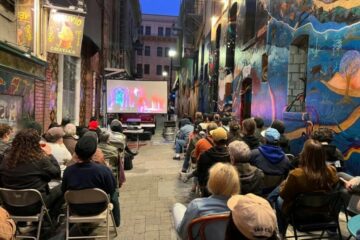The City That Was: An Evening of Civil Disobedience With The Billboard Liberation Front
In The City That Was, Bohemian Archivist P Segal tells a weekly story of what you all missed: the days when artists, writers, musicians, and unemployed visionaries were playing hard in the city’s streets and paying the rent working part time.
Improving Advertising
Being a member of the Cacophony Society pretty much guaranteed there would rarely be a dull week. People came up with endless weird-ass things to do, which either appealed to your sense of fun— or not. If nothing compelling was happening in Cacophony proper, there were also things going on in splinter groups affiliated in some marginal way, or hosted under assumed names to protect the unrepentantly guilty.
The Billboard Liberation Front, a holdover from the Suicide Club days, was one of those splinter groups full of friends with pseudonyms. They were at the extreme forefront of culture-jamming, which reminds us we can reject the onslaught of intentional conditioning designed to make us brain-dead consumers. Their goal was to improve advertising, changing it to make it infinitely more interesting, which could be thought of as a “benefit” to advertiser. Their billboards finally got some real attention.
The BLF didn’t post their events in the monthly newsletter, because the element of surprise was essential, when doing something so unfortunately illegal. We did hear rumblings around the kitchen table at 1907.
This is how it went: a billboard that begged for improvement was identified, and the Front’s advance team went to scout it, in white workers’ jumpsuits and a panel van with some faux and bland company name on the side. They climbed the ladder to the billboard and measured the size of the typeface, observed the font, and carefully noted the background color (graphic artists were essential for these parts).
Back at the ranch, the improved message was made on the same kind of waterproof substance that the original billboard was printed on. When finished, the Front brought the improvements back to the billboard, turned off the lights, climbed up, and tacked them on. This exercise in free speech wasn’t at all destructive. The better message could easily be removed without damage to the original ad—after it had been enjoyed by thousands of people in freeway gridlock in the morning.
This sounded like too much fun to me, and I really wanted to go along on one of these outings. However, I’m more competent in the mental world than the hazardous physical one, and I’ve had to be rescued more than once by someone, usually John Law. I was not a good candidate for climbing around on billboards. But my friends assured me that there was plenty to do on these escapades that called for participants with my skills. One night I finally got to go.
“You’re going to be on a diversionary team,” they told me, as we headed out to the site in the wee hours. Diversionary teams got placed, usually in pairs, a block on each side of the billboard. If a police car approached in the direction of the action, the team raised a stink to attract the attention of the law. Heated, screaming arguments (Italianate street theater) always got the cops to pull over and keep an eye on the possibility of domestic violence happening on the street. Also the screaming alerted the Front that they should finish up and scramble down.
I only got to participate in the improvement of one billboard, but it was one the most memorable acts of civil disobedience I’ve ever committed. Advertising has taken over our lives and reason, and I personally think (I’m a therapist, so it’s at least an educated guess) that advertisers’ constant snatching of our attention must have something to do with the spike in cases of attention deficit disorder. So there was something rewarding about opposing Big Ad, if only that once.
Security was pretty lax in those days, too. Skeleton keys could get you into lots of places and control panels. Security isn’t so lax any more, thanks to the fear-mongering security industry’s grip on our neuroses. It’s a lot easier to get into much more trouble for doing a whole lot less these days. So it’s especially great that people now go through more security and greater risks to give us ads worth reading.
The photographers who took these photos really prefer to remain somewhat anonymous.





